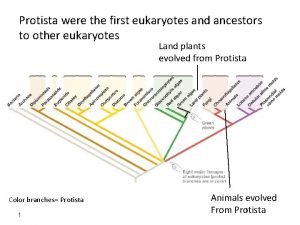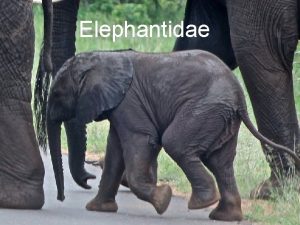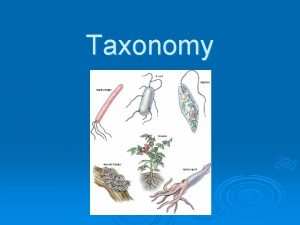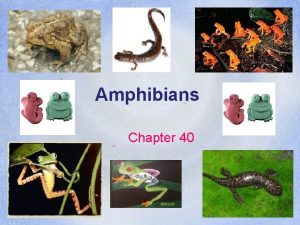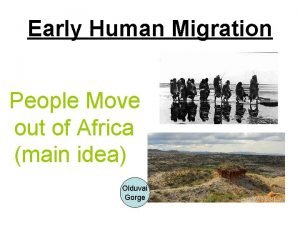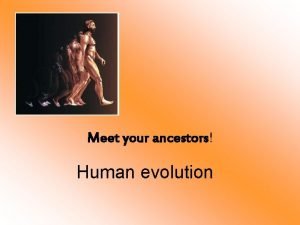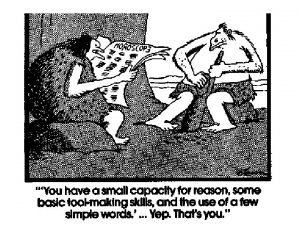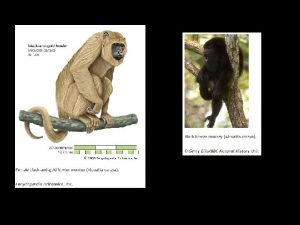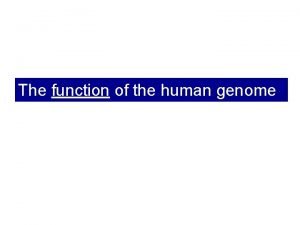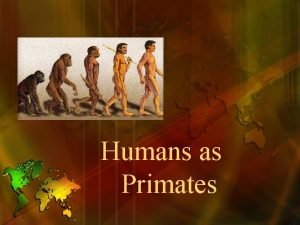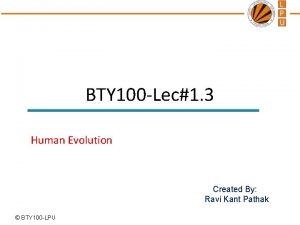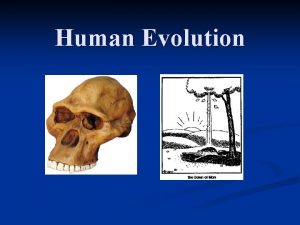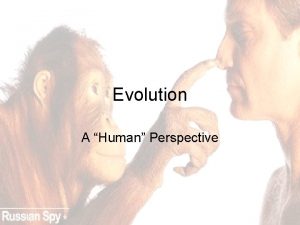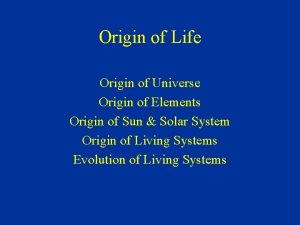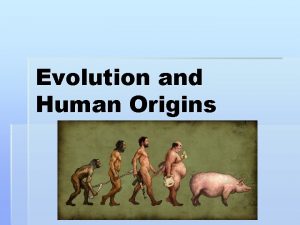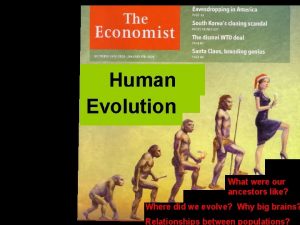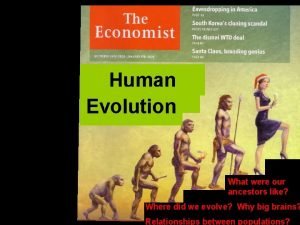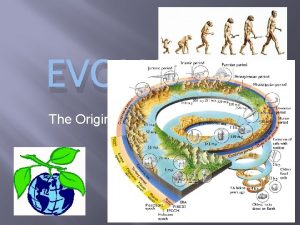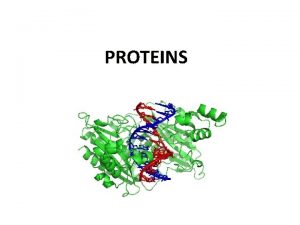Meet your ancestors Human evolution ORIGIN AND EVOLUTION

































- Slides: 33

Meet your ancestors! Human evolution

ORIGIN AND EVOLUTION OF MAN • About 15 mya, primates called Dryopithecus and Ramapithecus we re existing. • They were hairy and walked like gorillas and chimpanzees. • Ramapithecus was more man-like while Dryopithecus was more ape-like. • Few fossils of man-like bones have been discovered in Ethiopia and Tanzania

dryopithecus • Hairy , Walked like gorilla, chimpangees


• Early Great Apes Dryopithecus africans • Left the trees ca. 20 million years ago • Bipedalism by at least 6 Ma. arms and legs of same length.

Ramapithecus(man like) • Jaws , teeth like humans • Could walk like errct on its hind feet • Walked upright

Jaws and teeth like humans

Australopithecus 1 st ape man • Lived in E. arican grass land • 2 mya • Hunted with stone weapons but ate fruits • Errect posture • Bipedal locomotion

australopithecus • Brain capacity=600 cc

• Australopithecines probably fed in forested areas and would emerge into more open grasslands to scavenge and also grub for roots and tubers.





Homo habilis • Homo habilis which lived from 2. 5 million years ago until 1. 6 million years ago, • Bipedal locomotion • Errect did not eat meat • Brain capacity 650800 cc

• It is believed that Homo habilis were the first hominids to create and use tools.

Homo erectus • • Discovered in java. 1. 5 mya Brain capacity 900 cc Ate meat

• Historians believe that Homo erectus began as gatherers but advanced over many generations into hunters. • With the discovery of fire, Homo erectus became even more adept at survival.

Homo erectus which lived from 1. 8 million years ago to 100, 000 years ago, and

Homo sapianens neanderthalensis • • 1, 000 to 40, 000 yrs. Brain 1400 cc Walked upright Hides to protect their body • Buried dead



• Neandertals which lived from 230, 000 years ago until 30, 000 years ago. • What makes these animals so interesting is that they are our genetic ancestors and our evolutionary cousins. • These species represent a very small part of the unbroken evolutionary tree from those first living organisms that appeared 3. 5 billion years ago to every living thing on planet Earth today, including us!

Homo Sapiens It is believed that modern humans like you and I first originated on the Earth around 50, 000 years ago in Africa.

• As Homo sapiens migrated outward from Africa, it is believed that they wiped out Neanderthals, either by absorbing them through intermarriage, or by destroying them through war and competition.

Homosapiens • • 75, 000 -10, 000 yrs ago Cave art development Hominids evolved and developed for millions of years prior to the arrival of Homo sapiens on the Earth. This evolution was slow. The development of a new skill, or tool often took thousands of years. With the arrival of Homo sapiens, this all changed. The speed of advancements increased dramatically. Instead of thousands of years, great progress was made in hundreds or even dozens of years.





FROM APE TO MODERN MAN

TIME NAME PERIOD 15 mya 2 mya BRAIN CAPACITY REMARKS DRYOPITHECUS EAST AFRICA, ASIA; CLOSELY RELATED TO CHIMPANZEE; MORE APE LIKE, HAIRY, ARMS AND LEGS OF SAME LENGTH RAMAPITHECUS MAN LIKE; SHIVALIK HILLS; ERECT POSTURE; TEETH LIKE MODERN MAN AUSTRALOPITHECUS( CAVE DWELLERS) 500 CC 4 FEET TALL, WALKE UPRIGHT, HUNTED WITH STONE WEAPONS; ATE FRUITS; AFRICAN APE MAN; Homo habilis 650 -800 cc FIRST HUMAN LIKE BEING, Hominid; TOOL MAKER; COMMUNITY LIFE. DID NOT EAT MEAT 1. 5 mya Homo erectus 900 CC KNEW HOW TO USE FIRE, LARGE TEETH, ATE MEAT 10000040000 NEANDERTHAL MAN 1450 CC EAST AND CENTRAL ASIA; USED HIDES TO PROTECT THEIR BODY AND BURIED THEIR DEAD. 7500010000 Homo sapiens 1650 cc AROSE DURING ICE AGE; MODERN MAN; HEIGHT 1. 5 TO 1. 8 MTS ; FLAT FACE; 18000 PRE HISTORIC CAVE ART DEVELOPED

• Around 8, 000 years ago a new way of providing food emerged. This revolutionary advancement was that of farming. • Instead of hunting and gathering food from the environments where they lived, humans learned to simply grow their own food.
 God be with you till we meet again images
God be with you till we meet again images Ancestors prayer
Ancestors prayer My sojourn in the lands of my ancestors
My sojourn in the lands of my ancestors Restrictive clause definition
Restrictive clause definition Patrician carrying busts
Patrician carrying busts Ancestors of bears
Ancestors of bears It is considered as the ultimate ancestor of the computer.
It is considered as the ultimate ancestor of the computer. Protist evolution
Protist evolution Ravi got milk for the kitten from
Ravi got milk for the kitten from Mulan praying to ancestors
Mulan praying to ancestors Patrician forehead
Patrician forehead Primelephas
Primelephas Grouping objects or information based on similarities
Grouping objects or information based on similarities Section 40-1 review origin and evolution of amphibians
Section 40-1 review origin and evolution of amphibians Frog digestive system diagram
Frog digestive system diagram Origin and evolution of amphibia
Origin and evolution of amphibia Reproductive system of amphibians
Reproductive system of amphibians A:nice to meet you b:
A:nice to meet you b: Hello, my name is linda. nice to meet you.
Hello, my name is linda. nice to meet you. Meet your meat
Meet your meat Nice to meet you what's your name
Nice to meet you what's your name Give us your hungry your tired your poor
Give us your hungry your tired your poor Folk vs pop culture
Folk vs pop culture When did humans leave africa
When did humans leave africa Mythological origin of your planet’s name
Mythological origin of your planet’s name Ppt ok
Ppt ok Dryopithecus tagalog
Dryopithecus tagalog Australopithecus vs paranthropus
Australopithecus vs paranthropus Human evolution
Human evolution Human evolution
Human evolution Primates characteristics
Primates characteristics Human evolution
Human evolution Human evolution
Human evolution Human needs and human development
Human needs and human development







